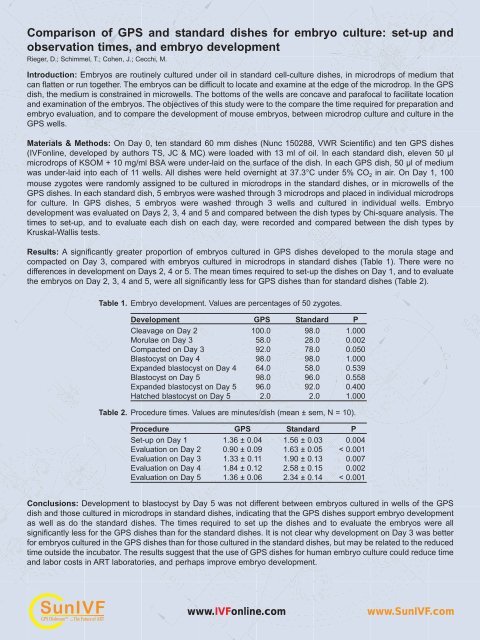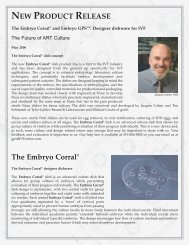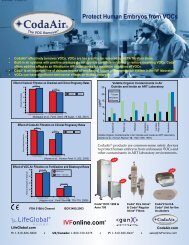the embryo gps® dish - IVFOnline.com
the embryo gps® dish - IVFOnline.com
the embryo gps® dish - IVFOnline.com
Create successful ePaper yourself
Turn your PDF publications into a flip-book with our unique Google optimized e-Paper software.
Comparison of GPS and standard <strong>dish</strong>es for <strong>embryo</strong> culture: set-up andobservation times, and <strong>embryo</strong> developmentRieger, D.; Schimmel, T.; Cohen, J.; Cecchi, M.Introduction: Embryos are routinely cultured under oil in standard cell-culture <strong>dish</strong>es, in microdrops of medium thatcan flatten or run toge<strong>the</strong>r. The <strong>embryo</strong>s can be difficult to locate and examine at <strong>the</strong> edge of <strong>the</strong> microdrop. In <strong>the</strong> GPS<strong>dish</strong>, <strong>the</strong> medium is constrained in microwells. The bottoms of <strong>the</strong> wells are concave and parafocal to facilitate locationand examination of <strong>the</strong> <strong>embryo</strong>s. The objectives of this study were to <strong>the</strong> <strong>com</strong>pare <strong>the</strong> time required for preparation and<strong>embryo</strong> evaluation, and to <strong>com</strong>pare <strong>the</strong> development of mouse <strong>embryo</strong>s, between microdrop culture and culture in <strong>the</strong>GPS wells.Materials & Methods: On Day 0, ten standard 60 mm <strong>dish</strong>es (Nunc 150288, VWR Scientific) and ten GPS <strong>dish</strong>es(IVFonline, developed by authors TS, JC & MC) were loaded with 13 ml of oil. In each standard <strong>dish</strong>, eleven 50 μlmicrodrops of KSOM + 10 mg/ml BSA were under-laid on <strong>the</strong> surface of <strong>the</strong> <strong>dish</strong>. In each GPS <strong>dish</strong>, 50 μl of mediumwas under-laid into each of 11 wells. All <strong>dish</strong>es were held overnight at 37.3°C under 5% CO 2 in air. On Day 1, 100mouse zygotes were randomly assigned to be cultured in microdrops in <strong>the</strong> standard <strong>dish</strong>es, or in microwells of <strong>the</strong>GPS <strong>dish</strong>es. In each standard <strong>dish</strong>, 5 <strong>embryo</strong>s were washed through 3 microdrops and placed in individual microdropsfor culture. In GPS <strong>dish</strong>es, 5 <strong>embryo</strong>s were washed through 3 wells and cultured in individual wells. Embryodevelopment was evaluated on Days 2, 3, 4 and 5 and <strong>com</strong>pared between <strong>the</strong> <strong>dish</strong> types by Chi-square analysis. Thetimes to set-up, and to evaluate each <strong>dish</strong> on each day, were recorded and <strong>com</strong>pared between <strong>the</strong> <strong>dish</strong> types byKruskal-Wallis tests.Results: A significantly greater proportion of <strong>embryo</strong>s cultured in GPS <strong>dish</strong>es developed to <strong>the</strong> morula stage and<strong>com</strong>pacted on Day 3, <strong>com</strong>pared with <strong>embryo</strong>s cultured in microdrops in standard <strong>dish</strong>es (Table 1). There were nodifferences in development on Days 2, 4 or 5. The mean times required to set-up <strong>the</strong> <strong>dish</strong>es on Day 1, and to evaluate<strong>the</strong> <strong>embryo</strong>s on Day 2, 3, 4 and 5, were all significantly less for GPS <strong>dish</strong>es than for standard <strong>dish</strong>es (Table 2).Table 1. Embryo development. Values are percentages of 50 zygotes.Development GPS Standard PCleavage on Day 2 100.0 98.0 1.000Morulae on Day 3 58.0 28.0 0.002Compacted on Day 3 92.0 78.0 0.050Blastocyst on Day 4 98.0 98.0 1.000Expanded blastocyst on Day 4 64.0 58.0 0.539Blastocyst on Day 5 98.0 96.0 0.558Expanded blastocyst on Day 5 96.0 92.0 0.400Hatched blastocyst on Day 5 2.0 2.0 1.000Table 2. Procedure times. Values are minutes/<strong>dish</strong> (mean ± sem, N = 10).Procedure GPS Standard PSet-up on Day 1 1.36 ± 0.04 1.56 ± 0.03 0.004Evaluation on Day 2 0.90 ± 0.09 1.63 ± 0.05 < 0.001Evaluation on Day 3 1.33 ± 0.11 1.90 ± 0.13 0.007Evaluation on Day 4 1.84 ± 0.12 2.58 ± 0.15 0.002Evaluation on Day 5 1.36 ± 0.06 2.34 ± 0.14 < 0.001Conclusions: Development to blastocyst by Day 5 was not different between <strong>embryo</strong>s cultured in wells of <strong>the</strong> GPS<strong>dish</strong> and those cultured in microdrops in standard <strong>dish</strong>es, indicating that <strong>the</strong> GPS <strong>dish</strong>es support <strong>embryo</strong> developmentas well as do <strong>the</strong> standard <strong>dish</strong>es. The times required to set up <strong>the</strong> <strong>dish</strong>es and to evaluate <strong>the</strong> <strong>embryo</strong>s were allsignificantly less for <strong>the</strong> GPS <strong>dish</strong>es than for <strong>the</strong> standard <strong>dish</strong>es. It is not clear why development on Day 3 was betterfor <strong>embryo</strong>s cultured in <strong>the</strong> GPS <strong>dish</strong>es than for those cultured in <strong>the</strong> standard <strong>dish</strong>es, but may be related to <strong>the</strong> reducedtime outside <strong>the</strong> incubator. The results suggest that <strong>the</strong> use of GPS <strong>dish</strong>es for human <strong>embryo</strong> culture could reduce timeand labor costs in ART laboratories, and perhaps improve <strong>embryo</strong> development.www.IVFonline.<strong>com</strong>www.SunIVF.<strong>com</strong>
















